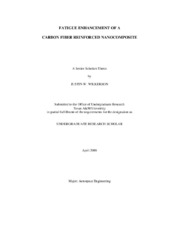| dc.description.abstract | The primary objective of the present investigation is to study the fatigue characteristics of a woven carbon fiber reinforced polymer which has been modified with either amine or fluorine functionalized carbon nanotubes on the fiber-matrix interface. Multi-wall functionalized carbon nanotubes are sprayed onto both sides of each fiber at 0.2-wt % with respect to the fibers. The composites are fabricated using high temperature vacuum assisted resin transfer molding with four-harness satin weave fabric and EPON 862/Epi-Kure W epoxy. Due to the heterogeneous nature of carbon fiber composites, under dynamic loading the composites undergoes a series of complex failure mechanisms: matrix cracking, fiber-matrix debonding, fiber fracture, and buckling. It is believed that debonding of the fiber-matrix interface is the most crucial of these failure mechanisms. Debonding of the fiber-matrix interface critically hinders the matrix’s ability to transfer loads to the fibers, leading to a poor distribution of load. Due to this distribution, one of three failures occurs: individual yarns of fibers are overloaded and fracture, the matrix losses strength and buckles, or a mixture of the two occurs. It will be shown that functionalized multi-wall carbon nanotubes can strengthen the fiber-matrix interface, resulting in fatigue life improvement.
The research investigates this behavior for both tension-tension and tension-compression fatiguing. It is believed that improvements will be best at negative R-ratios and high cycle regimes, because the damage is almost entirely matrix dominated occurs under these conditions. Results have shown improvements in static tensile properties of about twenty percent and an order of magnitude improvement in the fatigue life. Fractographic analysis reveals that the nanocomposites can withstand far greater matrix damage prior to final failure. In addition, both optical and scanning electron microscopy indicates that the nanocomposite exhibits reduced fiber-matrix debonding. | en |


